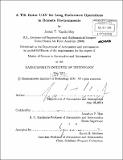A tilt rotor UAV for long endurance operations in remote environments
Author(s)
VanderMey, Josiah T
DownloadFull printable version (14.51Mb)
Alternative title
Tilt rotor unmanned aerial vehicle for long endurance operations in remote environments
Other Contributors
Massachusetts Institute of Technology. Dept. of Aeronautics and Astronautics.
Advisor
Jonathan P. How.
Terms of use
Metadata
Show full item recordAbstract
Extended mission times will greatly expand the utility of small UAVs that are currently limited to a single flight lasting no more than a few hours. This thesis assesses the challenges to developing a small, long endurance UAV and presents a preliminary vehicle and controller design for a tiltrotor UAV that achieves long endurance operation by combining autonomous takeoff and landing capabilities with a solar energy harvesting system. Mass and power models are developed for the proposed vehicle configuration to provide mission performance and sizing analysis. Results indicate that a feasible design exists that is capable of achieving multiple, successive flights with continuous operation from one hour after sunrise to one hour before sunset. Based on the sizing results, a prototype tiltrotor vehicle is built with on-board sensing and control to demonstrate the required takeoff control capabilities. The vehicle control architecture consists of a composition of locally valid feedback controllers. A nested PID linear feedback controller is implemented for the hover controller and dynamic inversion is used to cancel nonlinearities in the vehicle takeoff dynamics. Discontinuous control inputs during the transition between takeoff and hover controller modes are shown to result in undesirable transient behaviors that are mitigated by a an energy based switching algorithm. Using the prototype vehicle, the takeoff control algorithm is demonstrated successfully from several different terrains and starting orientations.
Description
Thesis (S.M.)--Massachusetts Institute of Technology, Dept. of Aeronautics and Astronautics, 2011. Cataloged from PDF version of thesis. Includes bibliographical references (p. 153-157).
Date issued
2011Department
Massachusetts Institute of Technology. Department of Aeronautics and AstronauticsPublisher
Massachusetts Institute of Technology
Keywords
Aeronautics and Astronautics.